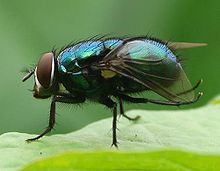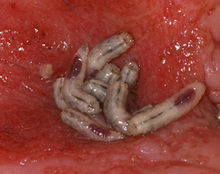- Lucilia silvarum
-
Lucilia silvarum 
Lateral view of Lucilia silvarum Scientific classification Kingdom: Animalia Phylum: Arthropoda Class: Insecta Order: Diptera Family: Calliphoridae Genus: Lucilia Species: L. silvarum Binomial name Lucilia silvarum
Meigen, 1826Synonyms The common toad fly, Lucilia silvarum, is a member of the fly family Calliphoridae. This fly was first discovered by Johann Wilhelm Meigen in 1826 and is found most notably in European and Western Countries.
This species of fly is known for its ability to readily cause myiasis, specifically this is done by the female gender of this species. In addition to being a species prevalent in myiasis, this fly is also known to be prevalent around rotting bodies as it is attracted to their smell, as well as areas of high filth concentration.
Contents
Description
Due to the fact that this fly belongs in the order Diptera, there is one pair of wings which it uses for mobility. The larvae of these flies are typically about 2 mm (0.08 in) long when laid, and grow in size to approximately 17 mm (0.7 in).[1] Because it is a member of the family Calliphoridae, this fly is generalized by metallic coloring and plumose arista. The adults (imago) of Lucilia silvarum are generally found to be between 4.5–10 mm (0.18–0.39 in).
Distribution
Since the fly has been found to be a warm-weather fly, it is typically found in areas with temperatures between 75 °F (24 °C) and 85 °F (29 °C). Specifically, Lucilia silvarum is found in the countries: China, Denmark, United States, Finland, southern Norway, North Africa, Russia, and Canada.[2][3]
Life cycle
 Life Cycle
Life Cycle
The life cycle begins with the mating of the male and female species of the fly and upon completion, the female begins oviposition and will lay the eggs on a place of interest such as an open wound, an orifice, or a pile of faeces. Once the eggs have been laid they will take approximately one full day to hatch, which is a short time period among flies.[1] Upon hatching, the larvae will begin the three stages of larvae development consistent with this family. The first stage occurs approximately after 2 days, while the second stage occurs after 2 and a half days, and finally the third stage occurs at approximately 4 to 5 days.[1]
Following the third stage of larval development, the larvae become uneasy and begin to roam away from their original resting place. It is during this stage that the larvae are now deemed a prepupae. This stage typically occurs 8–12 days after the eggs have been laid and will reach sizes up to 12 mm. Finally, the prepupae will begin to become a pupa after approximately 18–24 days, depending upon atmospheric conditions.
Lucilia Silvarum is one of the two species of blowflies that causes myiasis in anurans. This is extremely fatal to the host. The adult blowflies deposit their eggs on the anurans' backs which hatch into larvae after a couple hours. The larvae then burrows into the skin and causes lesions. However, because of their rapid growth rate, the larvae leave the amphibian's body in less than 1 week and migrate into soil in order to pupate. Generally, it takes them nine days to pupate into adult blowflies [4]
Ecology
Larvae of the family Calliphoridae are typically scavengers of carrion and dung but this species is also notorious for infesting necrotic tissue in animals and humans.[5] In reference to the adults, members of this family typically feed on nectar, sweet liquids, and things of that nature.[6] The specific distinction of the fly Lucilia silvarum that causes its common name to be the toad fly is the fact that at times the adult female will lay its eggs on toads and the larvae will become parasitic upon hatching. Studies have shown that typically parasitism by Lucilia silvarum has been fatal to their anuran host, but a recent study has found that there are two species of frog, the wood frog and boreal toad, that have actually been able to survive the parasitic larvae.[3] Some species of frogs that are typical hosts of Lucilia silvarum are listed below, but these specific hosts are specific to the Canadian regions.
- Rana sylvatica – the wood frog
- Pseudacris maculata – the boreal chorus frog
- Bufo boreas boreas – the boreal toad
- Bufo hemiophrys – the Canadian toad
Clinical importance
By far the most important clinical aspect of this species of fly is its causation of secondary myiasis in anuran hosts. Specifically, myiasis occurs when fly larvae, also known as maggots, infest living or necrotic tissue in either humans or animals.[7] One case of myiasis was observed in wood frogs, Rana sylvatica, in southeastern Wisconsin.[8] The results of the study suggest that this fly is a facultative parasite of this frog and other amphibians. Previous records of L. silvarum parasitism in North America showed that myiasis is fatal to anuran hosts.[9] However, after observations made from 1998 to 1999, infestations on Rana sylvatica(wood frog), Pseudacris maculata(boreal chorus frog), Bufo boreas boreas(boreal toad) and Bufo hemiophrys(Canadian toad) were reported. This is believed to be the first record of this parasite on boreal and Canadian toads. The most specific areas of occurrence for myiasis are in third world countries where common occurrences of misdiagnosis or no diagnosis occurs.
The use of maggots as a medical treatment was once used regularly as a verifiable medical procedure up until it started to be deemed as unclean and people became weary of having maggots placed on their flesh. Today, the use of maggots as a medical treatment is known as maggot therapy and has recently become far more prevalent in use and is specifically used to treat illnesses such as bed sores, foot ulcers, or post-surgical wounds.[10] Not only has maggot therapy become more prevalent, it was recently approved by the U.S. Food and Drug Administration as a relevant treatment for wounds in humans.[11]
Forensics
This fly species is typically the first genus of fly to show up on corpses, specifically in the United States and Canada. It is this important fact that causes this fly to be of great importance to forensic scientists, specifically in determination of time of death of an individual.
From stage to stage of this species' life cycle it is required for each particular larvae form to molt. It is this molting which allows forensic investigators to determine the time of death in forensic cases. Forensic scientists are able to measure the size of mouth parts, as well as the size of the individual larvae in order to distinguish a range of time of death for a deceased individual. However, the molting of larvae can be severely altered due to the climate, humidity, and other atmospheric conditions and all of these particular concerns must be taken into account before a precise time of death is determined.[1] In the case of this fly, if a forensic entomologist were to find an empty puparia, it would be determined that the deceased individual died approximately 20 days prior.[1]
References
- ^ a b c d e "Common insects in the early stages of decay". Forensic Entomology. http://www.freewebs.com/forensicentomology/earlycommoninsects.htm. Retrieved 2009-03-06.
- ^ Knut Rognes (1991). Blowflies (Diptera, Calliphoridae) of Fennoscandia and Denmark. Brill. ISBN 9004093044. http://books.google.com/?id=-0FA-Tp4UlEC&pg=PA181&lpg=PA181&dq=lucilia+silvarum%3B+meigen.
- ^ a b B. R. Eaton, A. E. Moenting, C. A. Paszkowski & D. Shpeley (2008). "Myiasis by Lucilia silvarum (Calliphoridae) in amphibian species in boreal Alberta, Canada". Journal of Parasitology 94 (4): 949–952. doi:10.1645/GE-1373.1. PMID 18576743. http://www.bioone.org/doi/pdf/10.1645/GE-1373.1.
- ^ http://www.bioone.org/doi/full/10.1645/GE-1373.1
- ^ John L. Foltz (2004-08-20). "Diptera: Calliphoridae". University of Florida. http://entomology.ifas.ufl.edu/foltz/eny3005/lab1/Diptera/Calliphorid.htm.
- ^ Peter Chew. "Blowfly - Family Calliphoridae". Brisbane Insects and Spiders Home Page. Archived from the original on 2009-10-24. http://web.archive.org/web/20091024110316/http://geocities.com/brisbane_flies/Calliphoridae.htm. Retrieved 2009-03-06.
- ^ Anna M. West. "Myiasis". Stanford University. http://www.stanford.edu/group/parasites/ParaSites2001/myiasis/Anna%20West's%20Myiasis%20Page.htm. Retrieved 2009-03-06.
- ^ Bolek, Matthew G and John Janovy Jr.2002. Journal of Wildlife Diseases 38(3):593-603.
- ^ Eaton, Brian R, Allisa E. Moenting, Cynthia A. Paszkowski and Danny Shpeley.2008. Myiasis by Lucilia silvarum(Calliphoridae) in Amphibian Species in Boreal Alberta, Canada. Journal of Parasitology 94(4):949-952.
- ^ Robin Lloyd (2008-11-19). "Maggot therapy gains in popularity". LiveScience. http://www.livescience.com/health/081119-maggot-therapy.html.
- ^ Jennifer Wenger (2004-07-20). "Are maggots making a medical comeback?". NIH Record. http://nihrecord.od.nih.gov/newsletters/2004/07_20_2004/story01.htm.
External links
Categories:- Calliphoridae
- Animals described in 1826
Wikimedia Foundation. 2010.

